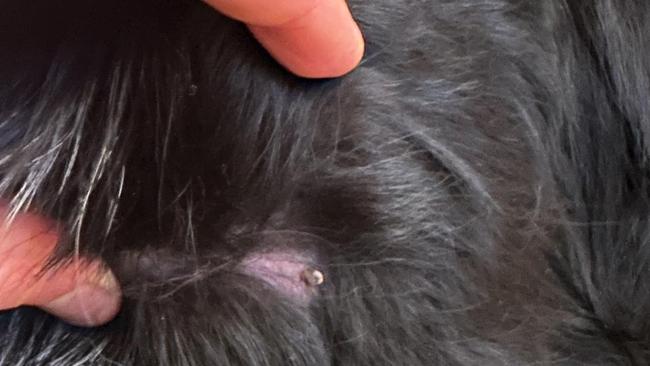Early tick season: What Aussie pet owners need to know
Pets presenting with tick paralysis symptoms have “tripled” in recent weeks, prompting vets to issues warnings of what to look out for.

Australian pet owners are being warned to be extra vigilant about deadly ticks, with experts reporting triple the amount of cases in recent weeks.
Dr Sam Kovac, of Southern Cross Vet, said the number of cases of dogs presenting with suspected tick paralysis had “tripled” of late, despite it not being summer.
“We are still in winter and there has been an uncharacteristic spike in tick envenomation cases. The increase has been bizarre,” Dr Kovac said.
He said climate factors, such as La Nina coming to an end, and cost of living pressures could be contributing to a perfect storm putting our furry friends at risk.

“Maybe the humidity in the ground is starting to evaporate and maybe making an ideal situation for paralysis ticks. Ticks like warm, moist places,” Dr Kovac said.
“Anecdotally, with rising cost of living, people are trying to look at ways to economise and unfortunately a lot of clients are backing off routine flea and tick treatments, especially in the winter months. Some are using the three month treatments but only every four months instead – but they don’t really work a day past what they’re supposed to.
“But tick paralysis can be costly too. It’s a false economy to save on tick prevention, when the cost of treatment could be $20,000 to $25,000 for (emergency) vet bills.”

It comes as Dr Chris Brown issued a warning about paralysis ticks earlier this month after he found two on his rescue dog Buzzy.
“Be careful out there … consider this the official warning that tick season is here … in early August!,” he wrote in a social media post.
“Buzzy is fine. Thankfully because he is on prevention, the ticks were dead.”

WHERE ARE TICKS FOUND IN AUSTRALIA?
Dr Kovac said there were two types of ticks in Australia that caused illness in dogs.
The brown tick, or cow tick, is located about 20 to 30km away from the coast. They can cause some sickness but are not life-threatening.
The paralysis tick, which causes death in animals, is found in coastal areas along Australia’s eastern flank in tropical, subtropical or northern temperate climates from northern parts of Victoria, throughout NSW and all the way to Far North Queensland.
They live in sand dunes or beaches and bushland surrounding national parks.
SYMPTOMS OF PARALYSIS TICK VENOM?
The venom in paralysis ticks works by targeting the nervous system, eventually resulting in the dog or cat being unable to walk and then suffocating because their diaphragm stops working and they “can’t get air into their lungs”, Dr Kovac said.
He urged pet owners to look out for symptoms of weakness, drool of vomiting up food, as well as a change in the sound of their bark or meow – a pitch higher or more hoarse may be a sign of them having a tick.
“Tick paralysis can kill a puppy within hours, and a big dog without a day or so,” Dr Kovac said.

MYTHS ABOUT TICKS?
It can take less than 30 seconds for ticks to transfer from dog to dog during play, or from the natural environment, Dr Kovac said.
And whether your dog is long-haired or short, ticks don’t discriminate.
“There’s a myth that collies can’t get them but they are the most at risk because you can’t feel for them as easily,” he said.
HOW TO SPOT TICKS?
“Ticks feel like a small skin lump. But unlike a lump, they have legs. In good light, you’ll see they are grey in colour and attached by their mouth,” Dr Brown said.
Dr Kovac said while 80 per cent of ticks were found in the front third of the animal’s body, around legs and chest, they can also be found in ears, in between toes or on eyelids.
HOW TO PREVENT TICKS?
Dr Brown urged pet owners to use tick preventive medications, to give animals the best chance.
Prevention medication kills ticks when they bite into the animal, as opposed to a deterrent, Dr Kovac said. The preventive, if taken as per the recommended schedule stays in the dog’s blood.
“The modern products are so good these days. But checking over your animal is a good habit to get into and beyond ticks, it's a nice bonding experience for the family and you can pick-up on other things at the time, like a melanoma,” he said.
More Coverage
Originally published as Early tick season: What Aussie pet owners need to know





